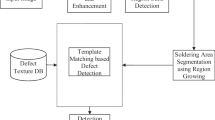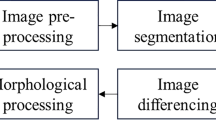Abstract
With the large variations in appearance for different kinds of defects in Printed Circuit Boards (PCBs), conventional rule-based inspection algorithms become insufficient for detecting and classifying defects. In this study, an automated PCB inspection system based on statistical learning strategies is developed. First, the partial Hausdorff distance is used to ascertain the positions of defects. Next, the defect patterns are categorized using the Support Vector Machine (SVM) classifier. Defects without regularities in appearance, which cannot be categorized, are identified through the regional defectiveness by comparing the block-wise probability distributions. Experimental results on a real visual inspection platform show that the proposed system is very effective for inspecting a variety of PCB defects.








Similar content being viewed by others
References
Moganti, M., Ercal, F., Dagli, C. H., & Tsunekawa, S. (1996). Automatic PCB inspection algorithms: a survey. Computer Vision and Image Understanding, 63(2), 287–313.
Chin, R. T., & Harlow, C. A. (1982). Automated visual inspection: a survey. IEEE Transactions on Pattern Analysis and Machine Intelligence, 4(6), 557–573.
Chin, R. T. (1988). Automated visual inspection: 1981 to 1987. Computer Vision, Graphics, and Image Processing, 41(3), 346–381.
Newman, T. S., & Jain, A. K. (1995). A survey of automated visual inspection. Computer Vision and Image Understanding, 61(2), 231–262.
Akiyarnai, Y., Hara, N., & Karasaki, K. (1983). Automation inspection for printed circuit board. IEEE Transactions on Pattern Analysis and Machine Intelligence, 5, 623–630.
Tominaga, S. (1991). Surface identification using the dichromatic reflection model. IEEE Transactions on Pattern Analysis and Machine Intelligence, 13(7), 658–670.
Spence, H. F. (1993). Printed circuit board diagnosis using artificial neural networks and circuit magnetic fields. In Proc. IEEE Systems Readiness Technology Conference, pp. 41–45.
Hodges, S. E., & Richards, R. J. (1995). Fast multi-resolution image processing for PCB manufacture. IEE Colloquium on Multi-resolution Modeling and Analysis in Image Processing and Computer Vision, pp. 1–8.
Scaman, M. E., & Economikos, L. (1995). Computer vision for automatic inspection of complex metal patterns on multichip modules (MCD-M). IEEE Transactions on Components, Packaging and Manufacturing Technology, 18(4), 675–684.
Wu, W. Y., Wang, M.-J. J., & Liu, C. M. (1996). Automated inspection of printed circuit boards through machine vision. Computers in Industry, 28(2), 103–111.
Loh, H. H., & Lu, M. S. (1999). Printed circuit board inspection using image analysis. IEEE Transactions on Industry Applications, 35(2), 426–432.
Kim, N. H., Pyun, J. Y., Choi, K. S., Choi, B. D., & Ko, S. J. (2001). Real-time inspection system for printed circuit boards. In Proc. 6th IEEE Int. Symp. Industrial Electronics, pp. 12–16.
Tominaga, S., & Okamoto, S. (2003). Reflectance-based material classification for printed circuit boards. In Proc. 12th Int. Conf. Image Analysis and Processing, pp. 238–243.
Ibrahim, Z., & Al-Attas, S. A. R. (2004). Wavelet-based printed circuit board inspection system. International Journal of Signal Processing, 1(1), 73–79.
Garcia, H. C., Villalobos, J. R., & Runger, G. C. (2006). An automated feature selection method for visual inspection systems. IEEE Transactions on Automation Science and Engineering, 3(4), 394–406.
Acciani, G., Brunetti, G., & Fornarelli, G. (2006). Application of neural networks in optical inspection and classification of solder joints in surface mount technology. IEEE Transactions on Industrial Informatics, 2(3), 200–209.
Chang, P. C., Chen, L. Y., & Fan, C. Y. (2008). A case-based evolutionary model for defect feature segmentation of printed circuit board images. Journal of Intelligent Manufacturing, 19(2), 203–214.
Huttenlocher, D., Klanderman, G., & Rucklidge, W. (1993). Comparing images using the Hausdorff distance. IEEE Transactions on Pattern Analysis and Machine Intelligence, 15(9), 850–863.
Cortes, C., & Vapnik, V. (1995). Support vector networks. Machine Learning, 20, 273–297.
Vapnik, V. (1998). Statistical learning theory. Chichester: Wiley.
Schölkopf, B., & Smola, A. J. (2001). Learning with kernels: Support vector machines, regularization, optimization, and beyond. MIT Press.
Bazaraa, M., & Shetty, C. M. (1979). Nonlinear programming. New York: Wiley.
Platt, J. C., Cristianini, N., & Shawe-Taylor, J. (2000). Large margin DAG’s for multiclass classification. Adv. Neural Information Processing Systems, vol. 12, pp. 547–553. MIT Press.
Hsu, C. W., & Lin, C. J. (2002). A comparison of methods for multi-class SVMs. IEEE Transactions on Neural Networks, 13(2), 415–425.
Wu, T. F., Lin, C. J., & Weng, R. C. (2004). Probability estimates for multi-class classification by pairwise coupling. Journal of Machine learning Research, 5, 975–1005.
Cover, T. M., & Thomas, J. A. (1991). Elements of information theory. Wiley.
Gonzalez, R. C., & Woods, R. E. (2001). Digital image processing (2nd edn.). Prentice Hall.
Benhabib, B., Charette, C. R., Smith, K. C., & Yip, A. M. (1990). Automatic visual inspection of printed circuit boards: an experimental system. International Journal of Robotics & Automation, 5(2), 1034–1044.
Widrow, B., & Hoff, M. E. (1960). Adaptive switching circuits. IRE WESCON Convention Record, Part 4 (pp. 96–104). New York: IRE.
Acknowledgements
This work was partially supported by the Center for Measurement Standards, Industrial Technology Research Institute, Hsinchu, Taiwan.
Author information
Authors and Affiliations
Corresponding author
Rights and permissions
About this article
Cite this article
Liao, CT., Lee, WH. & Lai, SH. A Flexible PCB Inspection System Based on Statistical Learning. J Sign Process Syst 67, 279–290 (2012). https://doi.org/10.1007/s11265-010-0556-8
Received:
Revised:
Accepted:
Published:
Issue Date:
DOI: https://doi.org/10.1007/s11265-010-0556-8




